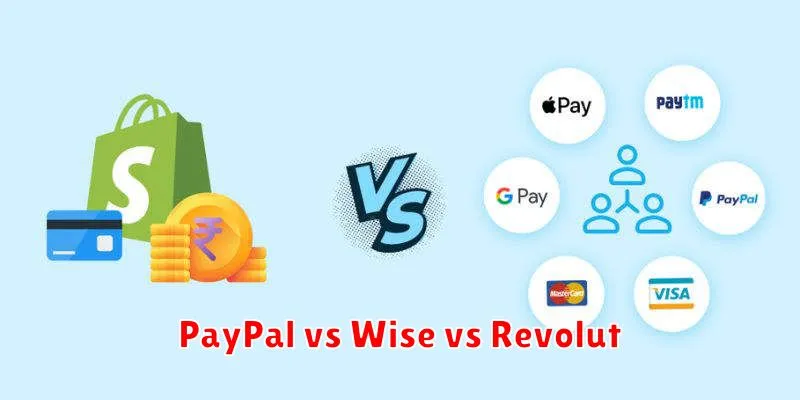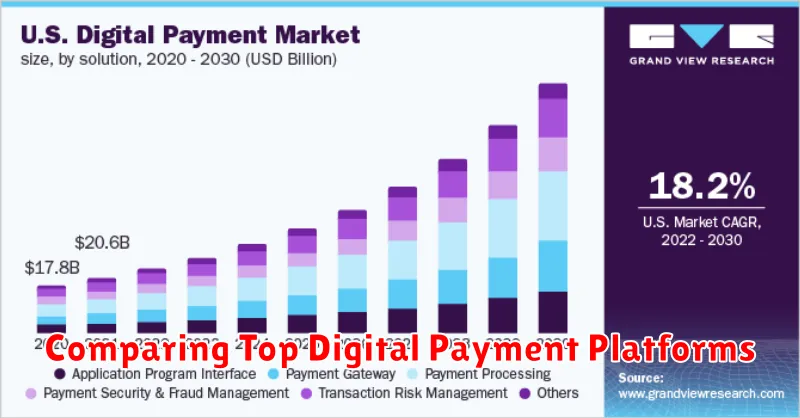In today’s fast-paced digital world, digital payment platforms have become essential for businesses and consumers alike. Choosing the right platform can significantly impact your financial efficiency and overall experience. This article provides a comprehensive comparison of the top digital payment platforms, examining their features, fees, security measures, and user experience. Whether you’re a small business owner looking for the most cost-effective solution or an individual seeking a seamless and secure way to manage your finances, understanding the nuances of each platform is crucial. We’ll delve into the strengths and weaknesses of each, helping you make an informed decision on which digital payment platform best suits your needs.
From established giants like PayPal and Stripe to emerging contenders, the digital payment landscape is constantly evolving. This comparison will explore key aspects such as transaction fees, processing times, integration options, and customer support. By evaluating these critical factors, we aim to empower you to select the best digital payment platform that aligns with your specific requirements. We’ll cover everything from mobile payment options to international transaction capabilities, ensuring you have a complete understanding of the available options in the competitive world of digital payments.
What Makes a Great Platform?
Several key factors contribute to a truly great digital payment platform. Security is paramount, encompassing robust fraud protection and data encryption to safeguard user information. A seamless and user-friendly interface is also crucial, allowing for quick and easy transactions regardless of tech proficiency.
Low fees are another important consideration, minimizing transaction costs for both consumers and businesses. Widespread acceptance is vital, ensuring usability across various vendors and locations. Finally, reliable customer support can make a significant difference in resolving issues and building user trust.
Beyond these core elements, additional features like rewards programs, budgeting tools, or integration with other financial services can further enhance the user experience and distinguish a platform from its competitors.
PayPal vs Wise vs Revolut

PayPal, Wise, and Revolut are all popular digital payment platforms offering various features and catering to different needs. This comparison highlights key distinctions to help determine which platform best suits your requirements.
PayPal is a well-established platform primarily focused on online transactions and merchant services. It offers robust buyer and seller protection, making it a trusted choice for e-commerce. However, its international transfer fees can be relatively high.
Wise (formerly TransferWise) specializes in international money transfers, emphasizing transparent fees and mid-market exchange rates. It is a cost-effective option for sending money abroad but offers limited functionalities compared to a full-fledged digital banking solution.
Revolut offers a broader range of services, including a multi-currency account, debit card, and budgeting tools, positioning itself as a digital banking alternative. While its international transfer fees are generally competitive, they can vary depending on the specific currencies and transfer speed.
| Feature | PayPal | Wise | Revolut |
|---|---|---|---|
| Primary Focus | Online Payments/Merchant Services | International Transfers | Digital Banking |
| International Transfer Fees | Relatively High | Low and Transparent | Competitive, Varies |
| Account Functionality | Limited | Limited | Extensive |
Supported Countries and Fees
A key factor in selecting a digital payment platform is its global reach and associated costs. Geographic availability varies significantly between platforms. Some cater to a broad international user base, while others primarily focus on specific regions. Understanding where a platform operates is crucial for businesses targeting particular markets.
Transaction fees are another critical consideration. These fees can differ based on factors like transaction volume, currency conversion, and the type of transaction (domestic vs. international). Some platforms may charge a flat fee per transaction, while others utilize a percentage-based model. Businesses should carefully evaluate these fee structures to optimize cost efficiency.
It’s also important to consider additional fees beyond transaction fees. These can include setup fees, monthly or annual account maintenance fees, chargeback fees, and fees associated with specific features like currency conversion or international transfers. Transparency in fee disclosure is essential for making informed decisions.
Transaction Speed and Limits
Transaction speed and limits are critical factors to consider when choosing a digital payment platform. Different platforms offer varying speeds, ranging from instant transfers to several business days for processing. These differences can significantly impact businesses and individuals, especially when dealing with time-sensitive payments.
Transaction limits also play a vital role. These limits, often imposed on a per-transaction or daily/monthly basis, can restrict the practicality of a platform depending on user needs. Higher limits are generally preferred for larger transactions, while lower limits might be sufficient for everyday purchases.
| Platform | Transaction Speed | Transaction Limits |
|---|---|---|
| Example Platform A | Instant | $10,000 per transaction |
| Example Platform B | 1-3 Business Days | $5,000 per day |
| Example Platform C | Instant | $1,000 per transaction |
Understanding these factors is essential for selecting the right platform that aligns with your specific transaction requirements.
User Reviews and Ratings
User reviews and ratings offer valuable insights into the real-world experiences of using different digital payment platforms. They can highlight strengths and weaknesses not readily apparent in marketing materials or official documentation.
Factors frequently considered in user reviews include:
- Ease of Use: How intuitive is the platform’s interface?
- Customer Support: How responsive and helpful is the support team in resolving issues?
- Security: How secure is the platform against fraud and unauthorized access?
- Fees: Are transaction fees clearly disclosed and reasonable?
- Features: Does the platform offer desired features like budgeting tools, peer-to-peer transfers, or international payments?
Aggregating reviews from various sources—app stores, social media, and dedicated review sites—can provide a comprehensive understanding of user sentiment towards each platform.
It is crucial to consider both the average rating and the distribution of ratings. A high average rating with a significant number of negative reviews might indicate underlying issues affecting a subset of users.
Security and Compliance
Security is a paramount concern when choosing a digital payment platform. Factors to consider include fraud prevention measures, data encryption, and secure authentication protocols. A platform’s security infrastructure should protect both businesses and consumers from unauthorized access and fraudulent activities.
Compliance with industry regulations is also crucial. Platforms should adhere to standards like PCI DSS (Payment Card Industry Data Security Standard) and other relevant legal frameworks. This ensures the secure handling of sensitive financial data and maintains customer trust.
When comparing platforms, examine the security features offered, such as two-factor authentication, tokenization, and fraud detection algorithms. Verify their compliance certifications and look for transparency in their security practices. A robust security posture and adherence to regulatory standards are essential for a trustworthy and reliable digital payment experience.

